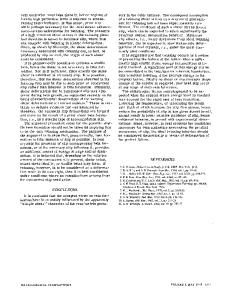Elastic strain energy of deformation twinning in tetragonal crystals
- PDF / 940,615 Bytes
- 10 Pages / 594 x 774 pts Page_size
- 26 Downloads / 417 Views
I.
INTRODUCTION
IN recent years, the importance of deformation twinning in the plastic deformation of ordered intermetallic compounds has attracted a growing interest, particularly for compounds of tetragonal crystal structures. [l] The role of deformation twinning in deformation behavior of materials is expected to further increase as advance in technology demands tougher and stronger crystalline materials which often possess limited operative slip systems. Accordingly, understanding of deformation twinning could set a higher capacity in the processing and mechanical behavior of these materials. The purpose of this work is to understand the energetic aspect of a twinning which has undergone a pure shear strain in materials of tetragonal structure. In the past, there have been several conference proceedings and excellent review articles covering various aspects of deformation t w i n n i n g . I2-7] Most of these works, however, have dealt with either crystallographic features or twinning dislocations. There have been, for good reason, very few works concerning the energetics of deformation t w i n n i n g . [8'91 In general, it is well accepted that the energy aspect is not of primary importance, especially for a deformation twin occurring in metals or compounds having structures of high symmetry. As discussed extensively in the literature, t2-7j for most metallic systems, much of the nucleation and growth phenomena of a deformation twinning has been reasonably understood in terms of twinning dislocations and/or stacking faults. J.K. LEE, Professor, is with the Department of Metallurgical and Materials Engineering, Michigan Technological University, Houghton, MI 49931. M.H. YOO, Senior Scientist, is with the Metals and Ceramics Division, Oak Ridge National Laboratory, Oak Ridge, TN 37831. Manuscript submitted December 11, 1989. METALLURGICAL TRANSACTIONS A
Certain crystals with a low symmetry, such as calcite and sodium nitrate, have demonstrated deformation twinning of elastic nature, which can be untwinned upon unloading, t31Although defects such as stacking faults may help to nucleate a deformation twin in such crystals, it is also well recognized that a deformation twin can homogeneously nucleate in regions of a high stress concentration. Certainly, the lower the symmetry of a crystal, the higher is the probability of nucleating a deformation twin in an elastic deformation process. For a case such as this, understanding the energetic aspect of a deformation twin becomes of prime importance. The elastic strain energy associated with a deformation twin is studied following Eshelby's inclusion theory, t~~ The tetragonal crystal systems studied here are fl-Sn, TiO2, and TiA1. A twin plate of an ellipsoid morphology is assumed to be embedded in an infinite matrix. To reflect the image nature of a twin against the matrix phase, the elastic constants of a twin are treated differently from the matrix elastic constants. Neither kinetic aspect nor the role of twinning dislocations is considered in this work.
II.
TH
Data Loading...











